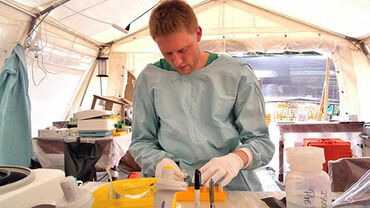Epidemiological update: outbreak of Ebola virus disease in West Africa, 23 October 2014Archived
Since December 2013 and as of 19 October 2014, WHO has reported 9 936 cases of Ebola virus disease (EVD) in West Africa including 4 877 deaths.
Situation in West Africa
Since December 2013 and as of 19 October 2014, WHO has reported 9 936 cases of Ebola virus disease (EVD) in West Africa including 4 877 deaths (Figure 1). The additional cases from the USA and the new case in Mali reported on 23 October have not been acknowledged by WHO and are not included in the overall figures.
The distribution of cases is as follows:
Countries having reported cases in the previous 42 days (affected countries according to WHO)
- Guinea: 1 540 cases and 904 deaths as of 19 October 2014;
- Liberia: 4 665 cases and 2 705 deaths as of 18 October 2014;
- Sierra Leone: 3 706 cases and 1 259 deaths as of 19 October 2014;
- Mali: one imported confirmed case from Guinea was reported in Kayes, Mali on 23 October;
- United States: four cases including one death. The last confirmed case occurred in New York on 23 October 2014;
- Spain: one case, no deaths. The case is the result of secondary transmission in Spain to a nurse who cared for an EVD patient who had been evacuated from Liberia isolated on 6 October 2014;
Countries having reported cases more than 42 days ago (previously affected countries according to WHO)
- Nigeria: 20 cases and 8 deaths. Nigeria was declared Ebola free on 19 October 2014;
- Senegal: 1 confirmed imported case, no deaths. Senegal was declared Ebola free on 17 October 2014.
Figure 1. Distribution of cases of EVD by week of reporting in Guinea, Sierra Leone, Liberia, Nigeria and Senegal, weeks 48/2013 to 43/2014*
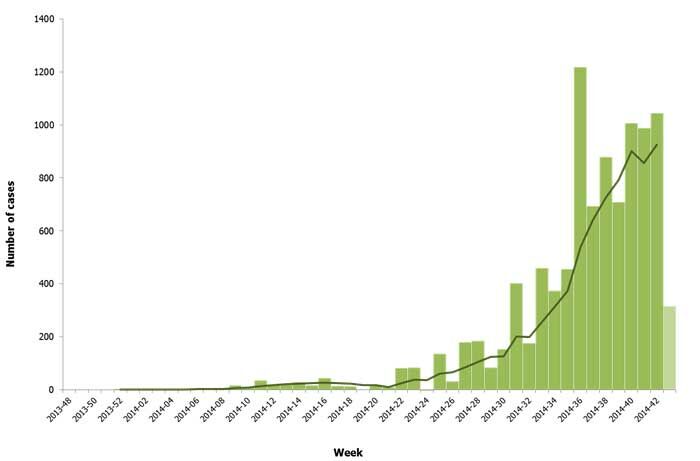
* The bar for week 43/2014 does not represent a complete week. The solid green line represents the trend based on a five week moving average plotted on the fifth week of the moving average window. The figure includes one imported case in Senegal.
The WHO Ebola response team showed that the current EVD cases present a similar course of infection, signs and symptoms when compared to previous outbreaks of EVD [10]. The incubation period was estimated to be 11.4 days with serial interval of 15.3 days. The case-fatality ratio estimated among 4 010 cases with known clinical outcome in Guinea, Liberia and Sierra Leone was 70.8% (95% CI: 68.6–72.8%) with no noticeable difference between the countries.
Situation in Guinea, Sierra Leone and Liberia
According to WHO EVD transmission remains persistent and widespread in Guinea, Liberia and Sierra Leone. Cases of EVD transmission remain lowest in Guinea, but case numbers are still very high in absolute terms. Transmission remains intense in the capital cities of the three most affected countries. Case numbers continue to be under-reported, especially from the Liberian capital Monrovia.
Figure 2. Distribution of cases of EVD by week of reporting in the three countries with widespread and intense transmission as of week 43/2014*
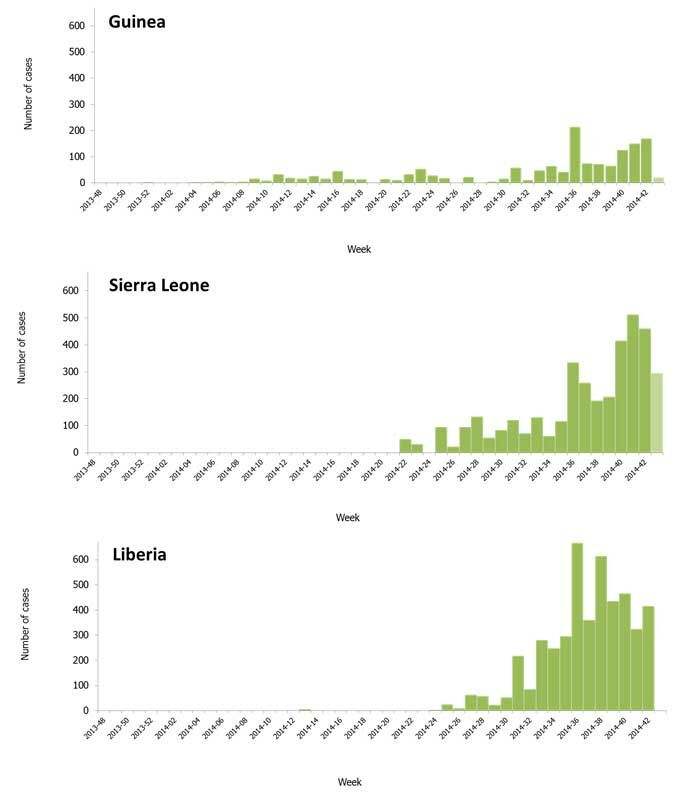
* The bar for week 43/2014 does not represent a complete calendar week.
Source: Data are based on official information reported by ministries of health up to the end of 19 October for Guinea and Sierra Leone and 18 October for Liberia [14].
Figure 3. Distribution of cases of EVD by week of reporting in Guinea, Sierra Leone and Liberia (as of week 41/2014)
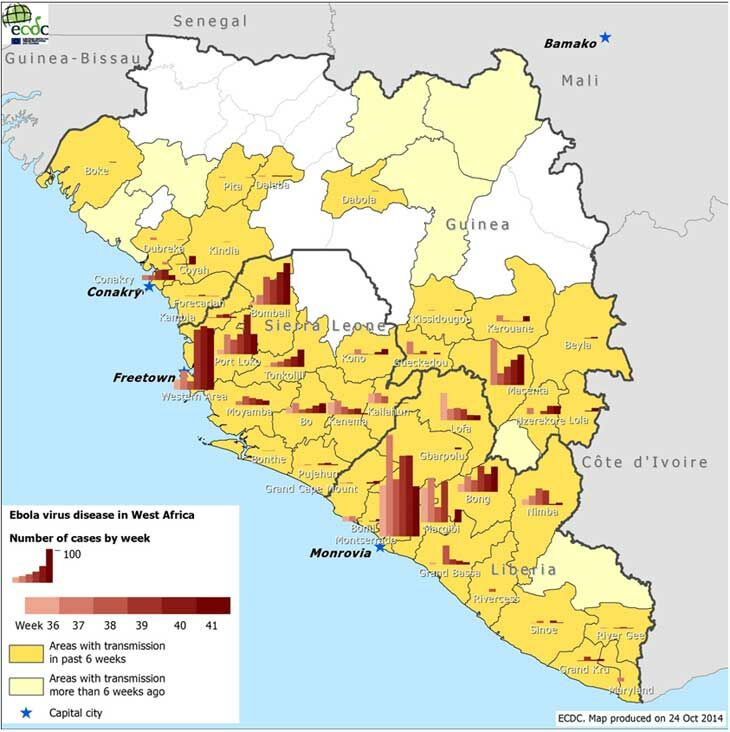
Source: Data from ministry of health reports (probable and confirmed cases).
Situation among healthcare workers in West Africa
As of 19 October 2014, WHO reported 442 healthcare workers infected with EVD of whom 244 died [15]. Table 1 details the distribution of cases and deaths among healthcare workers in the five affected countries
Table 1. Number of Ebola cases and deaths in healthcare workers in West Africa
| Country | Healthcare worker cases (% of reported cases) | Healthcare worker deaths (% of reported deaths) |
| Guinea | 78 (5.1) | 41 (4.5) |
| Liberia | 222 (4.8) | 103 (3.8) |
| Sierra Leone | 129 (3.5) | 95 (7.5) |
| Nigeria | 11 (55.0) | 5 (62.5) |
| Spain | 1 (100.0) | 0 |
| United States of America | 2 (66.0) | 0 |
| Total | 443 (4.6) | 244 (5.0) |
Source: data are based on official information reported by Ministries of Health [15]
Situation outside West Africa
USAOne new case has been reported on 23 October. The case is a medical doctor who volunteered in Guinea and recently returned to the United States [11].
On 20 October, Texas Health Department confirmed that 43 people in Texas who had contact with the state's first Ebola patient have been cleared from twice-daily monitoring after reaching the 21-day mark [16].
On 22 October, the US Department of Homeland Security (DHS) announced that all passengers arriving in the United States whose travel originates in Liberia, Sierra Leone or Guinea will be required to fly into one of the five airports that have the enhanced screening and additional resources in place. They will be actively monitored by public health authorities for 21 days. Travellers will receive a kit on arrival and must report every day to state or local public health. The kit contains information and a thermometer. They must take their temperature daily and advise whether they have any symptoms of illness. They must also disclose any intended travel. If individuals fail to report, "public health officials will take immediate steps to locate the individual to ensure that active monitoring continues on a daily basis" [17].
SpainNo new cases have been reported since 6 October in Spain when the health worker tested positive. On 21 October 2014, she was declared free of EVD. Eighty-three contacts are still under active follow-up [13].
MaliThe Ministry of Health in Mali has reported that a two-year-old girl who recently arrived from Guinea has tested positive for Ebola. This is the first confirmed case of Ebola virus infection in Mali [12].
Medical evacuations from EVD-affected countries
Seventeen individuals have been evacuated or repatriated from the EVD-affected countries (Table 2, Figure 4). As of 24 October, there have been nine medical evacuations of confirmed EVD cases to Europe (three to Germany, two to Spain, one to the UK, one to France, one to Norway and one to Switzerland) and two exposed persons have been repatriated to the Netherlands.
Table 2. Medical evacuation and repatriation from EVD-affected countries, as of 24 October 2014
| Date of evacuation | Evacuated from | Evacuated to | Profession | Status | Confirmed | Citizenship |
|---|---|---|---|---|---|---|
| 02 August 2014 | Liberia | Atlanta (USA) | Healthcare worker | Discharged | Yes | USA |
| 05 August 2014 | Liberia | Atlanta (USA) | Healthcare worker | Discharged | Yes | USA |
| 06 August 2014 | Liberia | Madrid (Spain) | Healthcare worker | Death | Yes | Spain |
| 24 August 2014 | Sierra Leone | London (United Kingdom) | Healthcare worker | Discharged | Yes | UK |
| 27 August 2014 | Sierra Leone | Hamburg (Germany) | Epidemiologist | Recovered | Yes | Senegal |
| 04 September 2014 | Monrovia, Liberia | Omaha (USA) | Physician (obstetrician) | Stable | Yes | USA |
| 09 September 2014 | Kenema, Sierra Leone | Atlanta (USA) | Physician | Stable | Yes | USA |
| 14 September 2014 | Sierra Leone | Leiden (the Netherlands) | Healthcare worker | Discharged | No | the Netherlands |
| 14 September 2014 | Sierra Leone | Leiden (the Netherlands) | Healthcare worker | Discharged | No | the Netherlands |
| 19 September 2014 | Liberia | Paris (France) | Healthcare worker | Discharged | Yes | France |
| 22 September 2014 | Sierra Leone | Madrid (Spain) | Healthcare worker | Death | Yes | Spain |
| 22 September 2014 | Sierra Leone | Lausanne (Switzerland) | Healthcare worker | Admitted | Unknown | Non-Swiss |
| 28 September 2014 | Sierra Leone | Maryland (USA) | Healthcare worker | Admitted | Unknown | USA |
| 02 October 2014 | Sierra Leone | Frankfurt (Germany) | Healthcare worker | Stable | Yes | Uganda |
| 02 October 2014 | Liberia | Omaha (USA) | Cameraman | Stable | Yes | USA |
| 06 October 2014 | Sierra Leone | Oslo (Norway) | Healthcare worker | Unknown | Yes | Norway |
| 08 October 2014 | Liberia | Leipzig (Germany) | Laboratory worker | Death | Yes | Sudan |
Figure 4. Medical evacuations and repatriations from EVD-affected countries, as of 24 October 2014
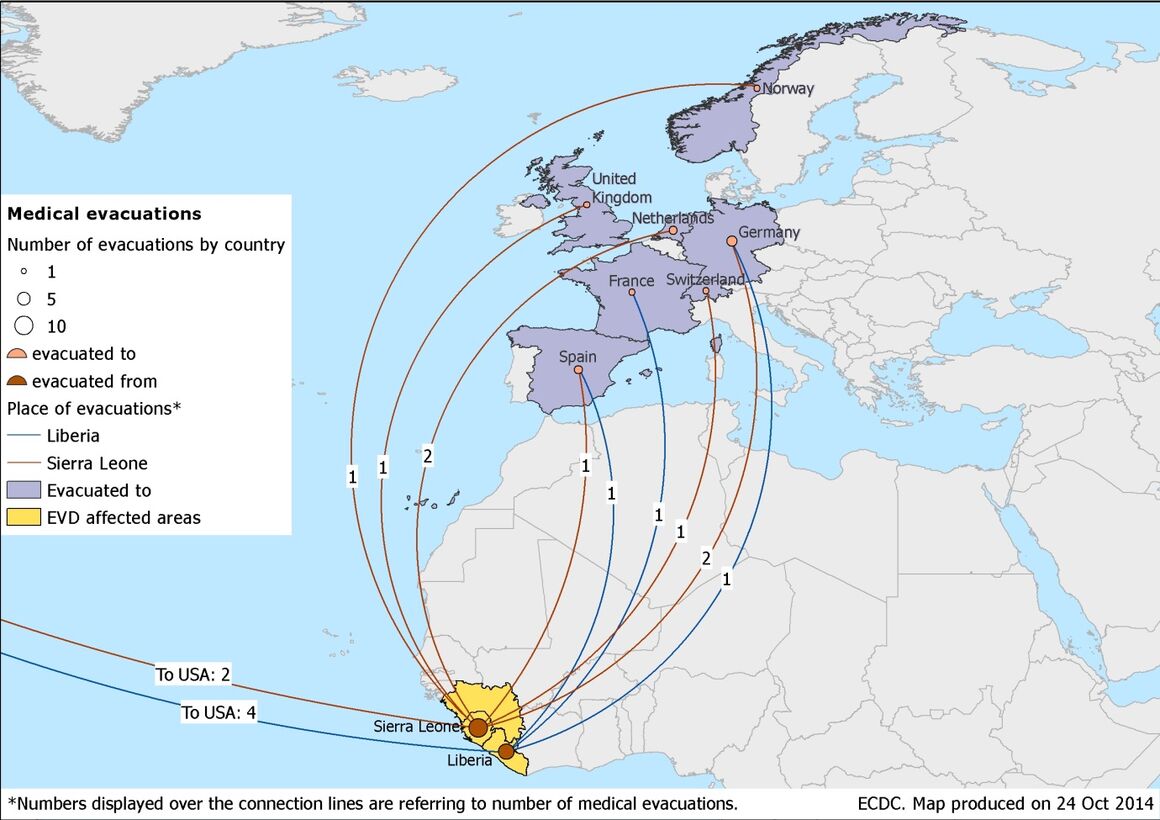
Chronology of events – key dates
23 October 2014: the US Centers for Disease Control and Prevention (CDC) reported a new case reported on 23 October in New York City. The case is medical aid worker who volunteered in Guinea and recently returned to the United States [11]. In addition, the Ministry of Health in Mali has reported that a two-year-old girl who recently arrived from Guinea has tested positive for Ebola. This is the first confirmed case of Ebola virus infection in Mali [12].
19 October 2014: Nigeria was declared Ebola free
17 October 2014: Senegal was declared Ebola free.
14 October 2014: In the USA, a second healthcare worker at Texas Health Presbyterian Hospital who also cared for the imported EVD patient tested positive for Ebola.
10 October 2014: In the USA, a healthcare worker at Texas Health Presbyterian Hospital who cared for the first imported EVD patient tested positive for Ebola.
6 October 2014: The Spanish authorities reported a confirmed case of EVD in a healthcare worker who cared for the second of two EVD patients that were evacuated to Spain.
3 October 2014: In Senegal, all contacts of the imported EVD case had completed the 21-day follow-up period without developing disease. No local transmission of EVD has been reported in Senegal. The imported case tested negative on 5 September and WHO declared Senegal free of Ebola on 17 October 2014 (two incubation periods after the last isolated case tested negative).
30 September 2014: The US Centers for Disease Control and Prevention (CDC) announced the first imported case of EVD in US linked to the current outbreak in West Africa.
23 September 2014: A study published by the WHO Ebola response team forecasted more than 20 000 cases (5740 in Guinea, 9890 in Liberia, and 5000 in Sierra Leone) by the beginning of November 2014 [10]. The same study estimated the doubling time of the epidemic at 15.7 days in Guinea, 23.6 days in Liberia, and 30.2 days in Sierra Leone.
18 September 2014: The United Nations Security Council recognised the EVD outbreak as a 'threat to international peace and security' and unanimously adopted a resolution on the establishment of an UN-wide initiative which focuses assets of all relevant UN agencies to tackle the crisis [9].
29 August 2014: The Ministry of Health in Senegal reported a confirmed imported case of EVD in a 21-year-old male native of Guinea.
8 August 2014: WHO declared the Ebola outbreak in West Africa a Public Health Event of International Concern (PHEIC) [7]. On 23 October, WHO re-confirmed that the outbreak continued to constitute a Public Health Emergency of International Concern.[8]
End of July 2014: A symptomatic case travelled by air to Lagos, Nigeria, where he infected a number of healthcare workers and airport contacts before his condition was recognised to be EVD.
May 2014: Sierra Leone and Liberia reported the first cases [5,6]. The disease is assumed to have spread from Guinea through the movement of infected people over land borders.
22 March 2014: The Ministry of Health in Guinea notified WHO about a rapidly evolving outbreak of Ebola viral disease (EVD) [1]. The first cases occurred in December 2013. The outbreak is caused by a clade of Zaïre ebolavirus that is related but distinct from the viruses that have been isolated from previous outbreaks in central Africa, and clearly distinct from the Taï Forest ebolavirus that was isolated in Côte d’Ivoire 1994–1995 [2-4] . The first cases were reported from south-eastern Guinea and the capital Conakry.
Download the data:
The following data are available to download as .csv files.
Please read The disclaimer and terms of use.
• EVD epicurve data
Cumulative number of cases and deaths for the five West African countries with reported EVD cases (Liberia, Guinea, Sierra Leone, Nigeria, Senegal). Source: WHO
• EVD map data
Cumulative number of cases and deaths at subnational level of the five West African countries with reported EVD cases (Liberia, Guinea, Sierra Leone, Nigeria, Senegal). Source: National situation report
For those weeks without reported data, the most recent figures were used as best estimate of the number of case).





